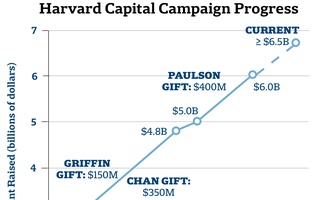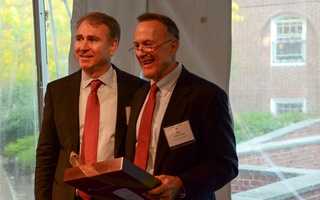Two years after the announcement of the public phase of Harvard’s capital campaign, the fundraising effort is already well on its way toward becoming the largest in the history of higher education. The University has already surpassed $6 billion in pledged support—more than 90 percent of the stated target of $6.5 billion, with three years still left before the campaign’s conclusion in 2018.
The latest report on the campaign’s progress reflects well on the University’s base of donors, and their connection to the school and its mission. At the same time, from here on out the University should focus on bolstering fundraising in areas that lag behind.
That University administrators have been able to raise such a large sum of money in so short a time speaks to their ability to make a convincing case about the importance of Harvard’s mission as a standard-bearer in higher education. By itself, the Faculty of Arts and Sciences—which has raised $2.2 billion of its $2.5 billion goal—has received donations from over 60,000 individuals. Harvard students, faculty, administrators, and alumni alike should be proud that so many people feel a strong enough connection that they are willing to give monetary support to the University.
Yet the numbers obtained by The Crimson also show that not all of the campaign’s priorities are faring as well as the FAS. Though some are doing even better—the School of Engineering and Applied Sciences, for example, has already raised 130 percent of its goal, due in part to the generosity of John A. Paulson—others have fallen short of expectations in comparison. Especially important is the slow progress of House renewal fundraising, which has raised less than 50 percent of its goal. The financial aid initiative, has also raised less than 65 percent of its goal, despite a $150 million donation from Kenneth C. Griffin ’89.
House renewal and financial aid may not be doing poorly in the grand scheme of things—reaching near to 50 or 65 percent of a goal before the halfway point can hardly be called a failure. They are simply overshadowed by the tremendous successes of other subdivisions of the campaign. Still, the University needs to pay special attention to equity in this campaign. One of the primary functions of the largest fundraising effort in higher education history must be to make sure the opportunities Harvard affords are more broadly available than ever before.
It is encouraging to see President Faust showing a commitment to boosting those fundraising priorities that are doing worse comparatively. Financial aid is especially important in the wake of recent reports that many schools across the country provide better for their low-income students than Harvard does.
To see such enthusiastic support from the University’s broad network of donors is heartening. As the campaign continues, it is imperative that the University not lose its focus on strengthening financial aid and other areas that provide equal opportunities. Making all students feel “fully included in the Harvard experience” is a worthy goal—and one that the Capital Campaign must not forget.
Read more in Opinion
Bovary and Avocado

















